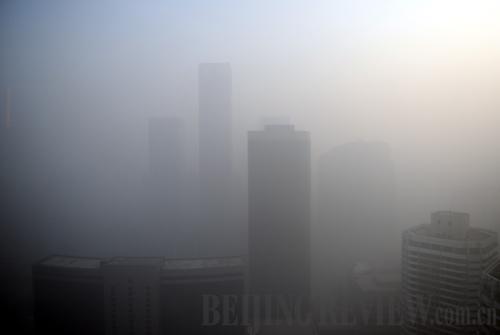Smoggy Solutions
Beijing Review, January 23, 2013 Adjust font size:
 |
|
Guomao area near Beijing's Eastern 3rd Ring Road is enveloped with heavy smog on January 12. |
Nine-hundred-ninety-three. Thus read the PM2.5 data from the air-quality monitor set at Beijing's downtown Xizhimen at 11 PM on January 12.
It means the density of airborne particles smaller than 2.5 microns in diameter is 993 micrograms per cubic meter—far exceeding the maximum pollution level of 500 and almost 30 times the level considered safe by the World Health Organization, which is 35.
The reading reached 300 on January 11 and remained above 400 in the following three days, according to the Air Pollution Index updated hourly by the Ministry of Environmental Protection. On January 12 and 13, it remained above 700 and in southeastern Beijing, 800.
Cities in other northern Chinese provinces, including Hebei, Henan and Shandong, also reported dangerously high PM2.5 data from January 11 to January 14, as smog blanketed some eastern and southern cities.
Hospitals in many cities reported a spike in respiratory and cardiac complications, especially among children and the elderly. In Beijing Children's Hospital, more than 800 children were being treated with steam humidifiers daily since January 11 and all doctors are fully booked till March 13. In southwestern Chongqing, patients admitted for respiratory and cardiac complications had increased by 30 percent since January 13. In Zhongnan Hospital of Wuhan University in Wuhan, capital city of central Hubei Province, 90 percent of the child patients it received after January 13 suffered from respiratory diseases, according to Wuhan Evening News.
Four deaths have been attributed to the smoggy weather. Two high school students were crushed to death in a train accident due to low visibility in the city of Chaohu in east China's Anhui Province on January 14. Thick fog was also blamed for the deaths of two people killed in a 20-car pileup in Zhejiang Province on January 15.
The low visibility also prevented Zhejiang authorities from spotting a furniture factory fire, which raged for four hours on January 14 before neighbors called firefighters.
Thick pollution
"Such prolonged pollution is rare in Beijing," said a university student who only gave his surname, Wang, to Xinhua News Agency. Wang has been living in Beijing since childhood.
However, another Beijing native, Wang Tianwei, said that he could give many other examples of extreme weather conditions in the past before data was available to show how bad conditions were. "The government is not concealing the data and we can at least know the true conditions we are in," said the 25-year-old.
Zhu Tong, an environmental sciences and engineering professor at Peking University, also cited research showing that the air quality in Beijing has not worsened in recent years.
"China previously used PM10, airborne particles measuring 10 microns or less in diameter, as its official standard for measuring air quality, but this does not assess smaller pollutants in the air," Zhu said. "People may think the air quality is worse, now that data based on stricter standards are released. But air quality may, in fact, be the same as in the past, when there was no official data to indicate such serious levels of pollution."
Experts with the National Meteorological Station said that relatively high humidity, low winds and a lack of cold fronts had contributed to the recent foggy weather in many parts of China.
"But the fog holds no pollution itself. The problem is the discharge of a huge amount of pollutants into the air each day," said Yu Jianhua, an official with the Beijing Municipal Environmental Protection Bureau.
Beijing has a permanent population of around 20 million and some 5.2 million vehicles, with the number of private cars on the rise. The exploding rate of car ownership in metropolitan areas, massive winter heating demands and terrain factors have also made it difficult to achieve satisfying results in efforts to improve air quality.
According to data from the country's auto industry, China remained the world's largest producer and market for automobiles for the fourth consecutive year in 2012, with auto sales at 19.31 million units and production at 19.27 million units.
Carbon monoxide, nitric oxide, nitrogen dioxide and other pollutants emitted by motor vehicles are among the major contributors to the air pollution problems like smog and acid rain that frequently occur in some Chinese cities.


